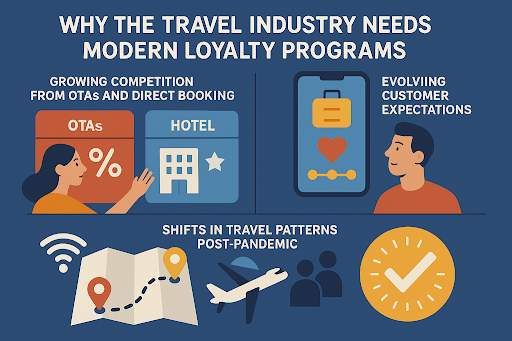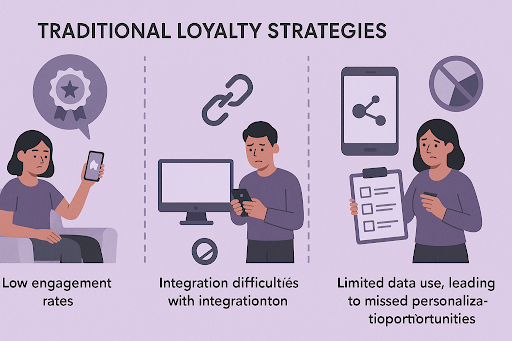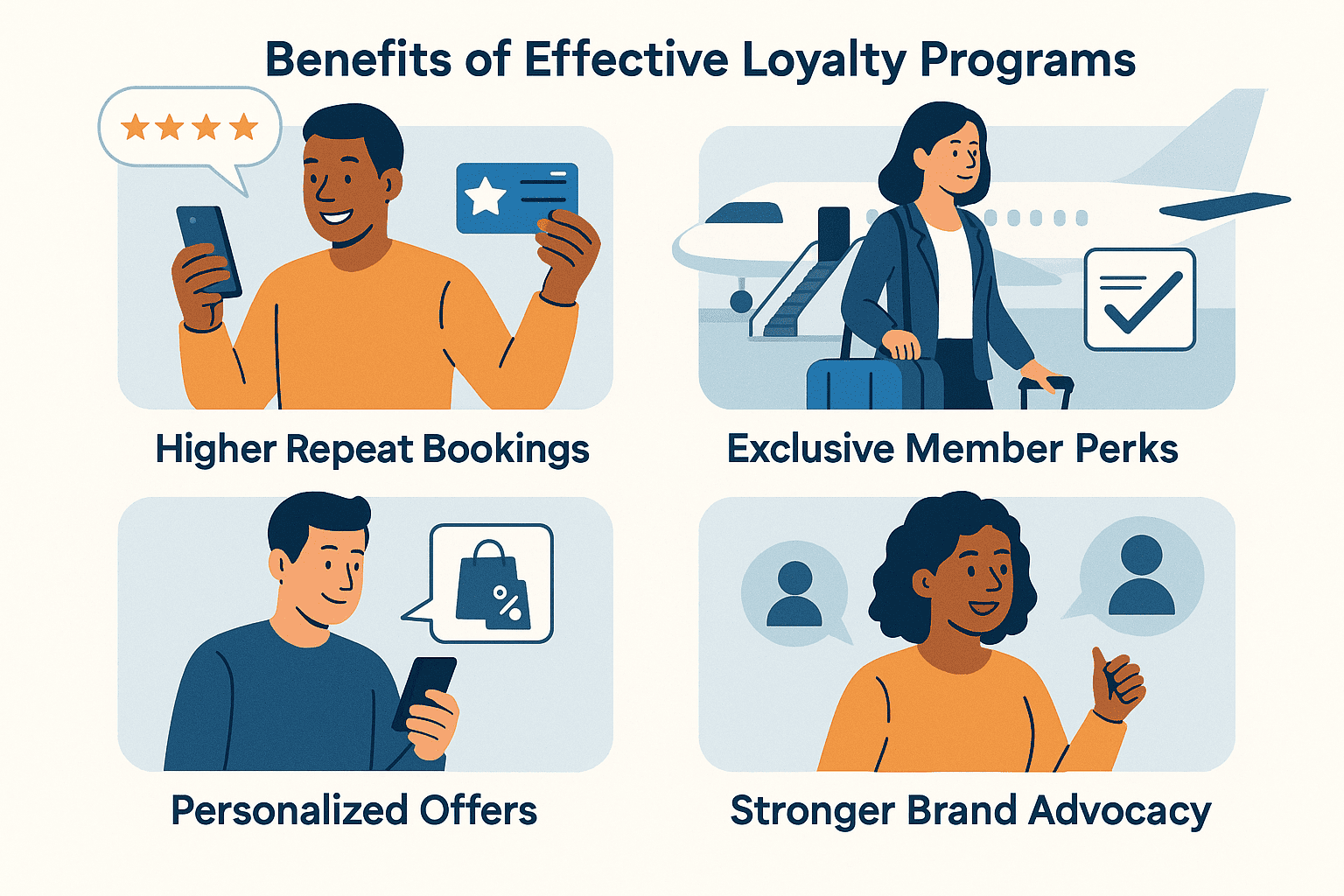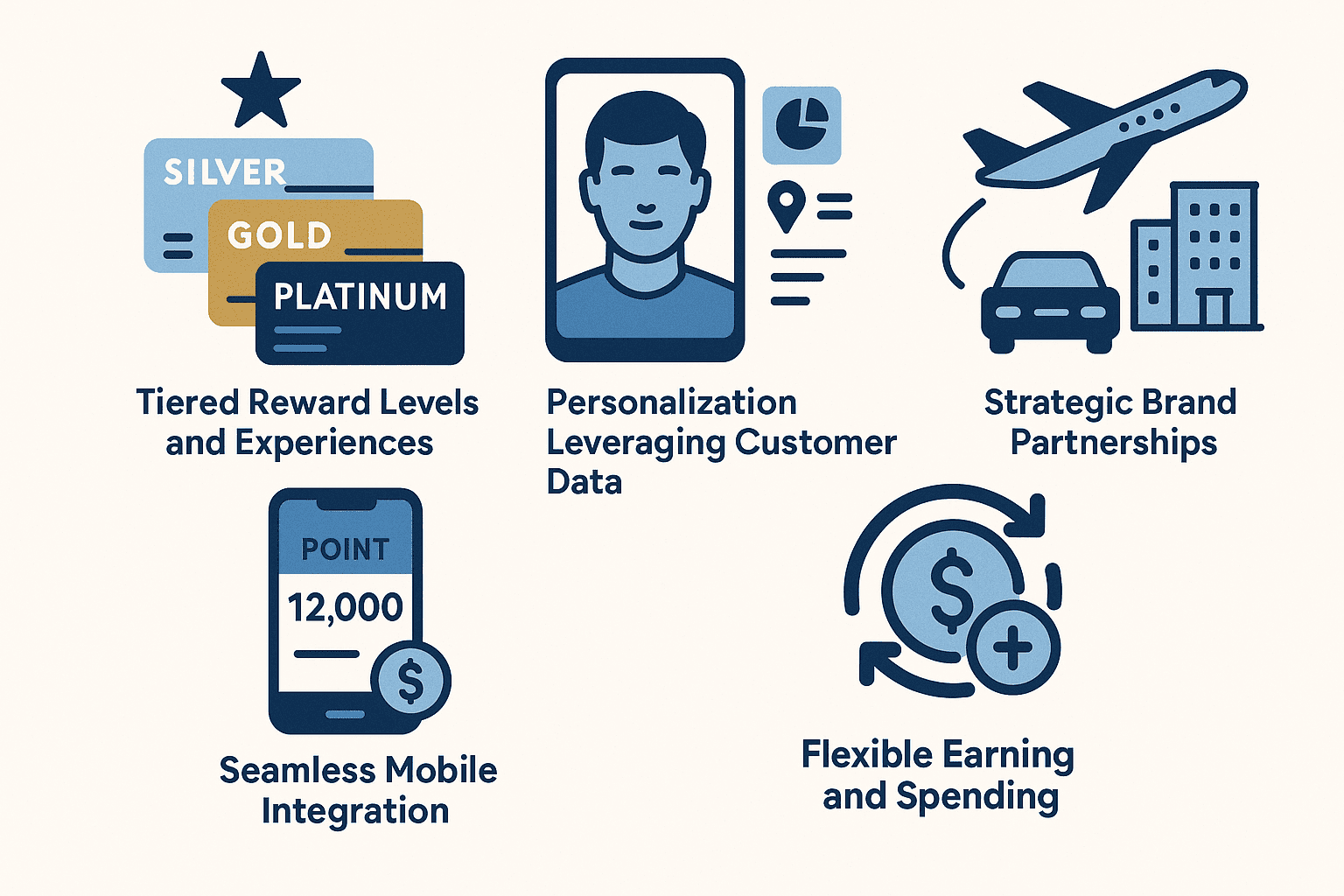
Travel
Travel Loyalty Programs That Actually Boost Repeat Bookings
Introduction: The Rise of Personalization in Travel
The evolution of travel loyalty programs has taken them beyond basic point accumulation systems which they were originally designed to be. These programs originally rewarded loyal customers through basic benefits such as trading stamps or flight mileage which could be exchanged for flights or hotel stays. The launch of airline frequent flyer programs during the early 1980s including American Airlines' Advantage led to a new travel era where customers could earn miles that granted them free flights and elite membership privileges.
The present-day travel industry loyalty programs use sophisticated engagement methods which create stronger emotional bonds with customers while allowing businesses to identify different customer segments and enhance long-term retention. Modern loyalty programs exceed traditional reward systems through technology and data capabilities which address the elevated expectations of present-day travelers. This includes features like:
- Dynamic Pricing: The value of rewards changes according to market demand which allows customers to redeem points flexibly.
- Personalization: Programs deploy sophisticated analytics systems to generate unique offers and customized experiences for individual customer preferences.
- Expanded Partnerships: Members benefit from earning and redeeming points throughout multiple travel and financial partners including airlines and hotels and car rental services and credit card providers.
- Status Tiers: Frequent travelers receive exclusive perks which include priority boarding and lounge access while these benefits develop stronger loyalty among members.
- Profit Centers: Many programs now drive significant revenue through third-party partnerships, such as co-branded credit cards.
These innovations have turned loyalty programs into powerful business assets, capable of adapting to changing travel habits and consumer demands while continuing to inspire loyalty in ever more competitive markets
Why the Travel Industry Needs Modern Loyalty Programs

The travel industry is transforming at a fast pace because of rising industry rivalry and shifting buyer needs together with post-pandemic travel trends. Travel brands require modern loyalty programs as their fundamental instrument to stay competitive while maintaining relevance. Here’s why:
Growing Competition from OTAs and Direct Booking
- Online travel agencies (OTAs) such as Expedia and Booking.com are continuously investing in their loyalty programs through which they have gathered hundreds of millions of members. The programs utilize advanced technology to deliver personalized deals and frictionless interactions that drive customer retention which poses a direct threat to hotels and traditional agencies.
- Hotels together with travel brands battle direct competition because travelers now prefer direct digital bookings to access personalized experiences and exclusive member benefits thus OTAs respond by increasing their loyalty initiatives.
Evolving Customer Expectations
- The modern traveler demands more than basic transactional rewards from their loyalty programs. Travelers seek programs which provide customized meaningful experiences instead of complicated generic point accumulation systems.
- Modern loyalty programs combine data analytics with AI capabilities to analyze traveler preferences before delivering customized benefits and maintaining engagement throughout the travel process thus transforming discounts into relationship-based loyalty systems.
- Travelers avoid rewards systems that are complicated because they want programs which are simple to understand and accessible through mobile devices while seamlessly integrating into their daily routines.
Shifts in Travel Patterns Post-Pandemic
- During the pandemic people altered their travel purposes and methods which generated increased demand for adaptable travel options with digital convenience and meaningful travel experiences.
- The rise of leisure travel alongside bleisure travel requires loyalty programs to deliver distinctive benefits which include mobile connectivity along with location-based advantages and community-focused rewards that align with new travel patterns.
- The pandemic has caused significant changes in how people travel to meet their needs.
- Post-pandemic travel patterns have transformed because travelers now focus on blending work and leisure while maintaining flexibility for last-minute changes.
- The pandemic introduced new travel patterns which focus on mixing work activities with leisure while allowing flexibility for sudden changes.
- The pandemic caused travelers to seek flexibility and convenience through online platforms while focusing on personalized experiences because health concerns and sudden travel restrictions
Modern loyalty programs provide travel companies with the following benefits:
- Travel companies who want to stand out in a competitive market must provide meaningful exclusive rewards to their customers.
- Travel companies can obtain important customer data despite third-party tracking restrictions by implementing modern loyalty programs.
- Modern loyalty programs enable travel companies to build enduring customer connections which leads to repeated bookings and enhanced customer lifetime value.
The essential components for achieving success in modern loyalty programs include:
- The combination of data analysis with technological systems allows travel companies to create customized rewards and experiences for their customers.
- Loyalty programs should maintain simple structures so customers can access them through their mobile applications.
- Travel companies should connect their loyalty programs with broader travel networks to deliver lifestyle advantages beyond point-based rewards.
Travel brands must incorporate modern loyalty programs because they operate in an actively changing market environment.
Limitations of Traditional Loyalty Strategies

The standard methods of customer loyalty programs do not meet the needs of present-day customers who live in a fast-paced digital environment. Previous loyalty programs which worked to increase repeat sales now show various weaknesses that reduce customer involvement and limit brand-consumer connections and future value potential.
Low engagement rates due to generic rewards
- Traditional loyalty programs distribute uniform rewards that fail to generate authentic interest among different groups of customers.
- More than half of all consumers stop participating in loyalty programs because the rewards they receive lack meaningful differentiation.
- The research indicates that 77% of reward programs which depend exclusively on point accumulation for purchases fail within two years because customers lose interest in their mundane incentives before seeking better alternatives.
- Loyalty program enrollment continues to remain strong but actual user participation remains low since less than 50% of loyalty members use their benefits consistently.
Lack of integration with digital platforms and mobile experiences
- Modern consumers require loyalty programs to operate seamlessly across different platforms particularly when accessed through mobile devices.
- The traditional loyalty programs operate independently from major digital contact points thus creating a disconnect between them and the overall customer journey.
- Digital systems that do not integrate effectively with customer touchpoints result in lost real-time engagement opportunities which makes customers feel neglected in digital experiences.
Limited data use, leading to missed personalization opportunities
- Legacy programs typically fail to collect and utilize detailed customer information that goes past simple purchase data.
- Brands face challenges to deliver personalized communication and rewards because they lack advanced analytics and data-driven insights which according to 76% of consumers is fundamental for building loyalty.
- Retailers encounter difficulties to adjust to new customer preferences and market changes because they have fragmented data systems which cannot produce actionable insights.
Brands need to transform their loyalty approach by integrating human-centric elements with data expertise and digital systems to stay relevant. Moving past standard rewards programs requires brands to focus on meaningful digital interactions and data-based personalization to restore customer trust and loyalty in the loyalty market.
Benefits of Effective Loyalty Programs in Travel

Travel industry loyalty programs that prove effective generate meaningful advantages for travel companies together with their customers. These programs implement points alongside perks and exclusive benefits that lead to repeated bookings and stronger customer retention and brand loyalty. Business clients together with frequent travelers base their airline and hotel choices on loyalty programs which leads to stable customer relationships.
Travelers participate in loyalty programs because they receive concrete benefits which elevate their ordinary travel experiences to premium levels through discounted fares and complimentary upgrades and priority services. Research indicates that 77% of consumers see loyalty rewards as an essential part of their travel budget while the majority find these perks indispensable for their journeys.
Travel brands maintain these programs for purposes which go beyond retaining their customers. Modern loyalty platforms gather essential data about customer preferences and booking patterns which companies use to develop targeted marketing strategies while customizing their product offerings. The approach based on data analysis strengthens personalized experiences and increases membership value perception which reduces user defection to rival brands.
Key benefits of effective loyalty programs in travel include:
- Higher Repeat Bookings: The opportunity to gather points and reach elite status encourages travelers to remain loyal to particular brands.
- Exclusive Member Perks: The combination of lounge access with free upgrades and priority boarding and late checkouts provides both practical benefits and emotional satisfaction to frequent guests.
- Personalized Offers: Brands use data collection to create individualized promotions which makes customers feel special and important.
- Stronger Brand Advocacy: Satisfied members regularly share their program recommendations with friends and colleagues which leads to natural growth of brand reputation.
The growing competition in hospitality combined with increasing consumer expectations makes travel loyalty programs essential for brands that want to maintain customer engagement and achieve business growth through their fulfillment of promises.
Key Features of Successful Travel Loyalty Programs

Travel loyalty programs that succeed in present-day competitive markets must implement key features which engage travelers while rewarding their loyalty and keeping them as returning customers. Such elements develop enduring customer relationships which leads to increased brand loyalty and revenue growth for travel businesses.
Tiered Reward Levels and Experiences
Top programs implement a defining characteristic which includes a tiered system that uses silver, gold and platinum labels. The system works because travelers gain better advantages when they advance through tiers including immediate discounts alongside room upgrades and exclusive experiences and growing perks based on their status level. Members of Hilton Honors and Emirates Skywards experience tiered incentives which provide specific benefits at every membership level.
Personalization Leveraging Customer Data
Effective programs use customer data to present individualized messages and promotions to their members. Through data analytics combined with AI-driven insights brands deliver tailored rewards and travel suggestions and experiences that match individual member preferences and historical travel patterns thus making members feel appreciated.
Strategic Brand Partnerships
Collaboration is another success factor. Various programs extend their benefits through alliance networks that include airlines together with hotel brands and car rental companies along with attractions and social benefit organizations. Members can earn points through more partners by using this system which increases earning options and boosts perceived value.
Seamless Mobile Integration
The modern traveler requires mobile access as an essential feature. Customers benefit from quick rewards access through a platform which features real-time point balance and simple redemption capabilities and instant benefits. The immediate point balance display together with hassle-free redemption options maintain member participation and their connection to the program.
Flexible Earning and Spending
The satisfaction level of members depends on flexibility. Travel programs which succeed provide members the ability to gather points from all booking sites and flight reservations and partner sites while letting them use points for diverse travel products by combining points with cash payment. The program's success in engagement depends on clear communication about points rules and expiration dates.
Key highlights at a glance:
- The organization of multiple loyalty levels motivates customers to return while giving benefits to dedicated patrons.
- The strategic application of customer information allows businesses to create significant personalized experiences.
- The program maintains extensive partner connections which enable customers to collect and use rewards through various channels.
- The program features mobile-optimized design that makes its functions easy to use through mobile devices.
- The program provides clear rules for earning and using rewards that offer flexibility to customers.
Travel brands can develop loyalty programs which differentiate themselves from competitors by integrating these features with strong technology and genuine customer attention to achieve both increased customer interaction and business expansion.
Technology & Investment Landscape
Loyalty management platforms stand as crucial tools for brands which want to enhance customer retention and strengthen engagement in today's competitive technology and investment landscape. Businesses must move past basic rewards platforms since they require solutions which deliver customized customer experiences while enhancing operational efficiency and enabling growth at scale.
The Value of CRM and Analytics Integration
- CRM systems that integrate with advanced analytics transform vast amounts of data into practical business insights. The integration provides these capabilities:
- Holistic customer profiles: Business success requires the creation of complete customer profiles through data aggregation from various touchpoints which produces understanding about behavioral patterns and engagement patterns for customized marketing and service approaches.
- Enhanced decision-making: The availability of real-time analytics enables teams to predict customer needs while delivering personalized communication which leads to proactive issue resolution that builds satisfaction and loyalty.
- Optimized sales forecasting: The use of predictive analytics helps businesses make more accurate revenue projections while revealing expansion possibilities that help organizations optimize their distribution of resources.
- Efficient operations: The use of automation tools along with intelligent recommendations enhances team productivity and streamlines workflows.
- CRM analytics tools which are fully integrated deliver a complete understanding of customer journeys while allowing better segmentation capabilities and trend identification for ongoing business enhancement.
Investment in Mobile-First User Experience and Automation
- Modern customers require seamless and straightforward interactions across all contact points with businesses. Organizations that adopt mobile-first UX investments obtain these specific advantages:
- Accessibility: Customers together with their staff members can use loyalty programs and service tools wherever they want and whenever they want to.
- Mobile platforms use real-time engagement to deliver timely offers and updates which boosts participation and value levels.
- Personalization: Automated, AI-driven recommendations enhance relevance and foster deeper loyalty.
- Automation creates greater effects through the following means:
- The system minimizes human involvement when entering data along with assigning cases and generating reports.
- Through AI-powered chat combined with knowledge suggestions and smart notifications companies can speed up their customer response times.
- The automation system allows organizations to grow their operations because small teams can handle large customer volumes while maintaining consistent service excellence.
The future success of organizations depends on investing loyalty management systems that merge CRM analytics and mobile-first design and automation capabilities. The implementation of these steps results in personalized data-driven engagement at scale and guarantees customer loyalty for the long-term.
Building a High-Impact Travel Loyalty Program
Designing an effective travel loyalty program for maximum impact requires both visionary planning alongside thorough knowledge of contemporary consumer needs. Modern travel brands need to transition from standard “earn-and-burn” programs to create genuine connections which lead to growth and customer satisfaction.
Define Customer Segments and Goals
Start your customer analysis by determining three main groups that include frequent business travelers and leisure explorers along with family vacationers who possess unique travel goals and spending patterns. Establish clear program goals:
- Increase booking frequency and customer retention
- Enhance brand engagement across all channels
- Drive higher revenue per customer
Through this specific understanding you can create rewards and communication approaches that directly speak to each segment thus achieving maximum relevance and effectiveness.
Design Compelling, Personalized Reward Structures
Contemporary travelers prefer rewards which are significant and adaptable to their needs. Strategies which work effectively include.
- The implementation of tiered reward systems that provide more valuable incentives to customers who increase their engagement or spending levels (such as elite perks and exclusive upgrades).
- The application of personalized benefits should utilize customer data to recommend rewards which align with their past travel experiences and individual preferences and sustainability choices.
- Experiential rewards consist of customized travel experiences and early event access and community benefits which create stronger emotional ties with customers.
- The redemption process should include flexibility which enables customers to use points for partial payments or partnerships and environmentally sustainable actions such as carbon offsets.
Integrate with Booking Engines, Mobile Apps, and Partner Networks
Your technology infrastructure must achieve seamless integration for optimal performance:
- Loyalty features must be embedded directly into booking engines to enable customers to earn points and redeem rewards instantly.
- Your mobile application should provide an easy-to-use interface that allows users to access customized rewards and monitor their points balance.
- The creation of a wider rewards ecosystem becomes possible through partnerships with hotels and car rentals and financial services and eco-conscious organizations which enhances customer value.
Data analytics serves to enhance engagement while increasing customer retention through its optimization processes.
Utilize analytics together with artificial intelligence to persistently enhance your loyalty program strategy:
- Real-time monitoring of customer actions enables personalized communication strategies together with customized offer delivery.
- Segment-based performance tracking should include key indicators such as retention statistics as well as average spending values and reward usage data.
- The analysis of data should lead to program tier adjustments and prompt promotional activities and partnership discovery opportunities.
Travel brands convert dust customers into dedicated lifelong advocates by creating loyalty experiences which are smooth and customized and valuable through human-first design and modern data and technology platforms.
Case Studies: Loyalty Programs That Drive Repeat Bookings
The travel industry loyalty programs continue to transform their approaches through airlines and hotel chains and OTAs to fulfill contemporary traveler needs.
Leading Airline’s Revamped Loyalty Scheme
A United States airline made major changes to its loyalty program through the integration of a booking platform which provides both convenience and increased reward value. The airline designed its rewards system to provide different benefits to members based on their status levels while allowing all customers to earn miles from hotel reservations. The immediate results proved highly successful:
- Hotel and car booking spending by customers rose 53% after the platform went live.
- The airline experienced a 37% increase in yearly bookings while its conversion rate doubled and its cancellation rate dropped almost 10%.
- A personalized booking system combined with seamless booking processes resulted in 65% higher revenue per booking while enhancing customer engagement and profitability.
A properly designed loyalty program functions to increase customer retention while generating additional revenue streams.
Hotel Chain’s Flexible, Experience-Driven Rewards Model
Hotel brands currently prefer loyalty systems which provide adaptable rewards and individual guest experiences instead of traditional point-based programs. Modern programs enable customers to trade their points for unique in-hotel experiences that include spa treatments and private dining alongside traditional free night redemptions. This approach:
- The method spreads across multiple traveler types thus creating stronger emotional connections and loyalty.
- Hotels use this strategy to present unexpected benefits to their guests throughout their stay starting from check-in upgrades up to late check-outs which boosts their chances of repeat bookings.
OTA Partnership Success: Cross-Brand Loyalty
The partnership between Online Travel Agencies (OTAs) enables members to receive benefits which they can take with them independently of airline or hotel brand affiliation. Through the union of loyalty accrual and redemption across numerous providers OTAs generate :
- Travelers find more value because they can earn and redeem rewards in various ways.
- The program maintains customer loyalty because its benefits remain available when travelers change brands or make bookings through the OTA.
Modern loyalty programs require more than transactional benefits because they need to deliver personalized experiences and flexible benefits and seamless integration. The transformation toward human-centered approaches becomes essential to make first-time travelers become permanent customers.
- Schedule a meeting to discuss more insights: Meeting Link
The Future: Personalization and Loyalty 2.0
The next generation of loyalty programs is evolving rapidly, leveraging artificial intelligence to create deeper, more meaningful connections with each customer. AI-driven recommendation engines are at the heart of this transformation, analyzing individual behaviors and preferences to deliver truly individualized rewards. These systems go far beyond generic points—by tracking everything from purchase history to browsing habits and even predicting future needs, brands can now delight members with rewards and offers that feel timely, relevant, and personal.
Key advancements driving Loyalty 2.0:
- AI-powered platforms analyze customer data in real time, allowing brands to:
- Suggest personalized offers at the moments customers are most likely to engage
- Predict and prevent churn by identifying subtle signs of disengagement
- Dynamically adjust rewards and tiers, keeping members excited and active
- Integration of gamification and experiential perks sets leading programs apart:
- Gamified challenges and milestone achievements create a sense of fun and accomplishment, encouraging ongoing participation
- Beyond material rewards, customers can unlock exclusive experiences, early access, or unique privileges
- Dynamic tiers and variable incentives—rather than rigid point systems—make the program adaptive and engaging
- The seamless omnichannel experience is redefining what it means to be loyal:
- AI personalizes interactions across web, mobile apps, and in-store visits, ensuring consistency and recognizing loyalty on every channel
- Real-time data flows allow instant recognition of member status or rewards, whether a customer shops online or in person, making every touchpoint feel unified and frictionless
- AI chatbots can provide proactive support and personalized product recommendations, further strengthening the customer-brand relationship
Interested in discussing how to bring these innovations to your loyalty strategy? Book a meeting here.
Conclusion
For travel brands aiming to stand out in a competitive landscape, it is essential to move beyond outdated, purely transactional loyalty programs. Today’s travelers demand much more than points—they want personalized experiences, flexible rewards, and genuine value woven into every step of their journey.
A modern loyalty program should do more than incentivize initial bookings; it must foster a sense of belonging and emotional connection, encouraging guests to return again and again. By leveraging customer data and advanced technologies, travel brands can transform their loyalty strategies into engines for long-term growth and deeper bonds with customers.
Key actions for travel brands:
- Invest in AI-powered personalization: Use intelligent systems to serve customized recommendations, relevant perks, and timely offers built around each customer’s preferences and travel history.
- Enhance reward flexibility: Empower members to choose how they earn and redeem, from flights and hotel stays to unique experiences or sustainable travel options.
- Prioritize seamless integration: Make loyalty benefits easy to access and redeem, reducing friction and embedding rewards directly into the booking journey.
- Gamify engagement: Introduce challenges, badges, and interactive campaigns to make the loyalty journey exciting and increase active participation.
- Align with purpose: Offer rewards and recognition for sustainable or community-minded choices, resonating strongly with today’s values-driven traveler.
Loyal customers are the cornerstone of profitability and enduring brand equity. By rethinking loyalty programs to focus on relevance, personalization, and memorable experiences, travel brands will not only increase repeat bookings but also nurture passionate brand advocates.
If your travel brand is ready to elevate its loyalty approach and create programs customers truly love, let’s talk about building a solution tailored to your audience’s needs. Contact us Today!

Your Tech Partner for Scalable Travel Growth
We’re here to help you shape your business, so reach out to us today.
